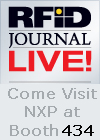Last spring, EPCglobal announced plans to create a standard air interface protocol for passive high frequency (13.56 MHz) tags (see EPCglobal Developing HF Tag Standard), which would provide end users the flexibility either to use HF or ultrahigh frequency (915 MHz) in their EPC deployments. That tag standard might not be ratified until the beginning of 2008, but NXP Semiconductors (formerly Philips Semiconductors) announced today the release of an integrated circuit, the ICODE UID-OTP, for HF tags based on the emerging standard.
Ed Gonsalves, business development manager for identification at NXP Semiconductors, explains that the UID-OTP supports many of the specifications upon which EPCglobal is building its HF standard. Because of this, he says, end users who begin using HF tags made with the ICODE UID-OTP chip will be able to migrate, through a reader firmware upgrade, to the EPCglobal HF standard when it is finalized.
|
|
RFID hardware and services provider Tagsys will be the first tagmaker to build the new chip into inlays. John Jordon, president of Tagsys’ worldwide field operations, says one of its clients has already completed field tests of the inlays with positive results. He says Tagsys will have production quantities of the HF inlays using the ICODE UID-OTP chip by year’s end.
Drugmaker Pfizer has been using Tagsys inlays containing earlier ICODE chips to track its Viagra product since early 2006 (see Pfizer Using RFID to Fight Fake Viagra). In November of last year, the company said it would begin testing HF tags compliant with the candidate HF standard, as part of its Viagra tracking pilot (see Pfizer to Tag Celebrex). Pfizer could not be reached to confirm whether it has yet tested the Tagsys tags with the ICODE UID-OTP chip.
According to Gonsalves, the UID-OTP chip has actually been under development for a number of years, starting when the Auto-ID Labs first established the EPC network architecture and the basic air interface requirements between tags and readers. At that stage, passive HF technology was more fully developed than passive UHF tags. As the Auto-ID Labs developed into EPCglobal and UHF tag standards took the forefront, NXP (then Phillips Semiconductor) slowed its work on a chip for EPC applications. As end users started looking toward HF technology for item-level tagging, NXP decided to turn back to its HF chip designed for EPC applications.
“When the Auto-ID Lab was creating an HF standard, the requirements were demanding,” says Gonsalves. “The tag had to have high read rates, the ability to support an EPC data construct, privacy protections had to be built into it—all the requirements that were transferred to the UHF standard.”
The UID-OTP chip supports higher read rates than current HF chips: up to 200 inlays carrying the chip can be read at once, he says, whereas no more than 100 HF tags can usually be simultaneously read. The UID-OTP also supports a password feature, which, when deployed, makes the tag data inaccessible to unauthorized readers. Unlike UHF Gen 2 chips, however, the data can only be written to the UID-OTP chip once. And as the EPC is being written to the chip’s memory, it is simultaneously locked so it cannot be later altered.
The UID-OTP differs from the candidate EPCglobal HF specification, however, in two important ways. It does not have enough memory to support a 128-bit EPC, so a 96-bit EPC must be used. And tag singulation schemes written into the EPCglobal specification, says Gonsalves, allow significant read-rate improvements over what the UID-OTP supports.
But because both the UID-OTP and candidate EPCglobal HF standard specification are backward-compatible to the ISO-15693 standard, end users who have deployed a reader architecture on the 15693 (or legacy ICODE protocols) will be able to upgrade the readers to read either UID-OTP tags or the EPCglobal HF standard tag (when it emerges) through a firmware upgrade.
Jordon also notes that EPCglobal has developed the reader command set for the candidate HF standard in harmony with the current reader command set for Gen 2 UHF tags; NXP has done the same for UID-OPT tags. Thus, it will be simpler and less costly for Tagsys and other RFID vendors to create multi-frequency readers able to encode and read both the HF and UHF tags.
NXP is making the ICODE UID-OTP chips available to tagmakers today. Sample pricing starts at around 6 cents apiece, depending on volume.


